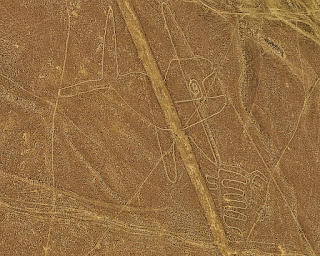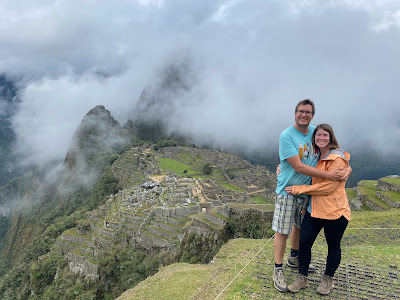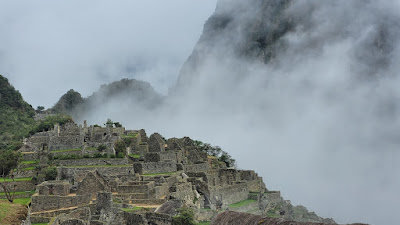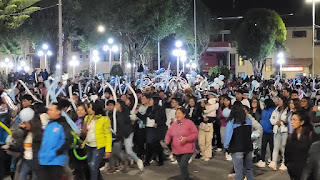Machu Picchu is one of the top sites in not only Peru but all of South America meaning that tickets to enter the site sell out. It is even on the latest list of the "New 7 Wonders of the World". Unfortunately for some of our friends on the road they were not able to acquire tickets to see the site but were nice enough to make sure we understood that the sooner we book tickets the better the chance we get the tickets we want for the day and time we want. Ever since purchasing our Machu Picchu tickets our timeline has been set in stone meaning that we no longer had the flexibility that we wanted. That being said we still tried to do everything we wanted to do which finally caught up to us in this blog post. This blog post is all about us rushing to Machu Picchu and only stopping for a quick flight around the Nazca lines. Although we tried our best to explore all the areas between Huacachina and Machu Picchu our tickets and timeline did not allow for much deviation.
September 28th –
Better out than in
Kendra’s day started very early
as she woke up feeling all the symptoms of food poisoning. Our nice dinner out on the town had
consequences for Kendra. Paul had gone
for a vegetarian meal for some reason so he was completely fine but Kendra’s
meat lasagna came back with a vengeance.
poisoning mantra that everything is better out than in at this point. He only left the pool area to check on Kendra after watching her make a mad dash to the toilets and he graciously went to the store to purchase electrolyte drinks and ginger ale. Thankfully hour by hour Kendra started to feel slightly better and keep some liquids in her body but we knew that it was better to take it easy today rather than make Kendra feel potentially worse by driving south all while leaving here without constant access to a toilet and garbage can (because they were both needed at the same time, ugh). Unfortunately due to road conditions and the date of our Machu Picchu tickets tomorrow would have to be a long driving day.
While Kendra deliriously rested
in the van, Paul made one final hike up the sand dunes for sunset, which did
not disappoint again. We really enjoyed
our time Huacachina and would have stayed longer if time would have permitted.
September 29- Nazca Lines
 |
| She's alive! |
 |
| Palpa Geoglyphs |
 |
| Rupert even joined us. |
We arrived at the Nazca airport which was the smallest airport we had ever been in. Everyone rushed us in the parking lot as we prepared the van to ensure it stays cool for Rupert while we took to the skies. Paul settled on the least pushy sales person who encouraged us to enter the airport and see the prices; spoiler alert: the prices are all the same starting at $60 usd to see 12 lines/geoglyphs and increasing in price up to $100 to see others lines and historical places in the area. We settled on the $60 tour and were weighed and copies of our passport were taken. However, this was a group tour meaning we would have to wait for another 3-10 people to fill the plane which could be an hour or more. Most flights and tours left in the morning as the air was less turbulent meaning it could be quite a while until a few other random people like us wander into the airport. Lucky for us after a short wait we were told we could have a private flight for two people for only $20 usd more and see more than just 12 lines and formations. With the dog in the car, we decided to charter a private plane and in 10 minutes we were taking off.
While this experience blew our daily budget, in hindsight it was worth it! We saw so many formations, our pilots pointed out all the ones we could see and circled around to make sure we got the photos we wanted. It was amazing how large these formations were and how they are practically impossible to see from the ground. They were designed within a grid system with starting points originating from hills and mountains. They were likely created for religious reasons and were created by removing the darker desert material allowing only the lighter material to show through.
 |
| Lizard, tree, toad/hands |
 |
| Monkey |
 |
| Astronaut |
 |
| Whale |
 |
| Condor or Hummingbird? |
We have never flown in a Cessna
and had read and heard that they are more prone to turbulence meaning that
although we enjoyed every moment of our flight we, especially Paul, were happy
to be back on solid ground as a few extra minutes may have resulted in some
clean up. There were no motion sickness
puke bags on our plane, (Paul made sure to check when we were 75% done the
flight). Luckily, Kendra doesn’t usually
get motion sickness so she was able to hold her own on this flight.
 |
| The people who made sure we didn't die! |
We had originally planned to
drive as far as possible today, but we were still 14 hours away from Cusco and
had spent way more time than planned exploring the Nazca area so ended up
camping close to a highway toll booth.
We had read it was a safe place to camp but Paul mistakenly drove into a
farmers field rather than the toll booth parking lot where people previously
had camped. Luckily the farmer was very
friendly, and although surprised we would want to camp in such a cold mountain
pass they did welcome us to their land. We
settled in for the night where Kendra ate her first solid food- ramen.
September 30- On the Road Again
 |
| A sweet quinoa road snack |
The blueberries were delicious,
we ate a couple from each container, told him which we prefer (we were not in
agreement) then tried to return the two massive containers of blueberries but
he refused to take them meaning we had tons of blueberries as road snacks for
the rest of the day (and likely enough for tomorrow as well).
 |
| Just some photos from the day |
We thought that we could drive 10
hours and make it to Cusco, but after 12 hours on the road and being 3.5 hours
away from Cusco it was time to stop for the night. Kendra debated between stopping at a hot
spring or a canyon, but the canyon was closer and had amazing reviews so we
spent the night with some beautiful views, sleeping only 40kms away from Machu
Picchu as the crow flies.
 |
| Not a bad view to end a long day |
October 1- Another day…
Today was Paul’s birthday and he
didn’t want to do anything special for it.
We started driving around 8:30 am with the hope of making
it…somewhere. The goal was really to
drive all day and get as far as possible.
We’ve realized that driving in Peru takes forever! Google and Waze are
quite inaccurate with approximate arrival times and travelling 200 kms will
take close to 5 hours.
After driving and driving some
more we arrived in the town of Urubamba.
We have heard there is good coffee here, but we had other
priorities. We needed money from the
bank (which like Peru driving took almost an hour to withdraw due to a machine
that Paul swears was powered by Windows 95), and Paul wanted a Birthday
Beer. We stopped in at Yucay Brewing for
beers and lunch and then it was time to head North towards Machu Picchu.
 |
| Birthday Beer |
Thankfully the drive was uneventful other than some rain although
there were too many switchbacks to count.
We were stopped at a police check point and Kendra had our papers all
ready to show them, but the police didn’t care about the papers. They only asked where we were from, where the
van was from, and about Rupert. They didn’t care about our names or anything
about us, they only wanted to know the dog’s name. We are pretty sure they were
just bored. We have read stories of corrupt police in Peru but still haven’t
had a corrupt encounter yet, but we are okay if we leave Peru without one.
 |
| Some bread we picked up for $3CAD. |
We made it to Santa Teresa as the
sun was setting and had a nice night in. Paul ate the last of our Besos (our
favourite Peruvian chocolate snack, think caramel wafer with soft marshmallow
covered by milk chocolate) and Kendra stomached some rice Paul had made.
October 2- Hidroelectrica
 |
| The road to Hidroelectrica (the non-river portion was open for us on the way back) |
We had again heard horror
stories
about the road from Santa Teresa to Hidroelectrica but we were pleasantly
surprised, after 20 minutes of driving and only one deep water crossing on the
official road we arrived Hidroelectrica. We found a camp spot for the evening,
met a tattoo artist from Toronto who was surprised to see a BC plated vehicle,
and got eaten alive by sand flies and small mosquitoes.
October 3rd – The
economical hike to Machu Picchu
 |
| The start of the hike |
 |
| Kendra questioning her life choices |
Kendra was still a bit sick and Rupert was quite lazy meaning the 10 kilometer hike took us a little longer than planned. Rupert hardly walked it as after a couple kilometers he decided he wasn’t interested in walking any more and quasi demanded to be placed into his backpack. The hike wasn’t ugly by any stretch of the imagination, it even gave us a view of the site from the river below the mountain that it was built upon.
 |
| Our first view of Machu Picchu from below |
 |
| The train we didn't take |
 |
| We made it! |
Our next tasks for the day were to purchase bus tickets from Aguas Calientes to the actual Machu Picchu site, an easy task just quite expensive. Return tickets for the next day where over $30 CAD each for a 15 minute bus ride in each direction. At least we didn’t have to hike up hill to Machu Picchu.
Our last task was to find our
hotel which we later learned had rebranded from a hotel with a 1 star rating on Google, requiring the assistance of a local
bartender to show us where it was. As
thanks we promised we would head to his bar for a drink after we explored the
town a bit. We ended up heading to his
bar for dinner, the food was good but the Pisco Sours he made were out of this
world. If the quality of Pisco Sours in
Peru were the same as we had at Tony’s bar
we would probably order them more often.
That being said we were looking
forward to acting like tourists, speaking a bit of English and socializing with
other travelers.
October 4th – To Machu
Picchu
 |
| People lined up for the bus |
Our hotel had a free breakfast
which was disappointing. It consisted of
stale bread with close to frozen butter and instant coffee. Although we thought about grabbing something
more for our time in Machu Picchu we decided instead to load our bag with
granola bars we had packed and head to the bus.
It was here where we said goodbye to Rupert as the actual archeological
site is not dog friendly. While we were exploring he slept in the hotel bed awaiting
our return.
The line up for the bus was long
with many people trying to sell you things or their services as a guide. We had been told that we should not get a
guide for a few reasons. They are expensive at, on average ~$100 CAD, but we
had also heard that due to the lack of information or history on the site that
many guides will make up information. On
top of that some guides have their English sales pitch down to a science but their
English skills quickly diminish as soon as they start the actual tour. Other issues we had heard were that the
guides want to return to the bus stop as soon as possible to sell their
services again to another traveler that they will rush you through the
site. Finally we were told that because
so many English people do hire guides it easy to freeload off of them by just
hanging around an area for a bit, we were told it is very easy to eavesdrop.
Before we knew it we were on the
bus and having our tickets validated for the site and the circuit we were
doing. There are 4 circuits but you can
only do one, they go in different areas of the site, but all 4 give you that
famous view of Machu Picchu. It is
wildly believed that circuit 1 or 2 are the best with circuit 3 being the least
desirable as this is the circuit large tour groups are required to take meaning
it is very busy and hard to get good pictures.
Because of when we purchased our ticket we could choose any circuit we
wanted so we choose circuit 2.
The best advice we can give to
anyone planning to visit Machu Picchu is to go slow, take your time and wait to
get that perfect photo. Also, with the circuit system you can only travel in
one direction on the circuit. If you
want to go back for another photo you cannot go back. We heard so many people being whistled at
trying to go the wrong direction to get “the photo”, but we were lucky that we
could stand and wait as long as we needed to get the photos we wanted.
October 5th – Doing
what we want, when we want
Our checkout time of our hotel was 9am so after another disappointing breakfast (it was free breakfast so we can’t really complain) we started our walk back to the van. For some reason we were all hiking like rockstars, even Rupert happily did 7 kilometers before letting us know he was ready to be carried. We happily walked down the train line talking about the last couple days before reaching an organic coffee plantation that we had passed a couple days ago. Knowing we had a couple hours to kill before the road leaving Hidroelectrica would open we decided to stop in.
 |
| This coffee is definitely organic! |
The drive was thankfully
uneventful from Hidroelectrica to Santa Teresa, this time we didn’t even need
to fjord a river. We had slightly missed
our window from Santa Teresa to Santa Maria (where we would return to the
Sacred Valley and an actual highway) so we decided to check out the hot springs
nearby.
The Cocalmayo hot springs just outside of Santa Teresa were amazing and are now our favourite south American hot springs. Although established and developed pools, it felt more natural than most with some walls being mountain side and a rock/pebble bottom. On top of that the pools were clean and smelled like nothing (as we would expect). The temperatures of each pool corresponded perfectly we the temperature of the area both in the heat of the day and in the middle of the night. There seemed to be a pool for every temperature. Hours melted away and our chances of leaving Santa Teresa disappeared. It's amazing that taking a photo of a hot spring that we actually enjoyed never crossed our mind. Since we were no longer in a rush to be anywhere this self imposed “choice” seemed to be the perfect reminder that we are entering a new chapter of the trip. We have no one visiting us, we have no wedding to attend nor vehicle shipping deadline or tickets to far away sites. We can do what we want when we want.



















































































